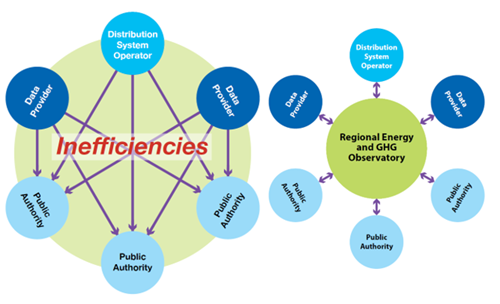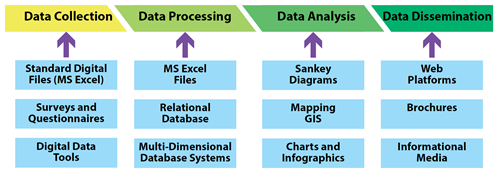Public sector, energy databases
References/sources
References represent DATA4ACTION project monitoring systems
Who needs to act?
Energy observatory, municipalities, Energy Data Providers, energy facilitators
Who is affected?
Municipalities, energy distributors and providers, individual consumers, buildings' owners
Solution
A major challenge in climate change mitigation is the timely access to robust energy data that can underpin local and regional sustainable energy policies and plans. The challenge demands a collaborative solution.

A collaborative partnership approach underpins successful sustainable energy planning. Effective data sharing involves practical collaborations between Public Authorities, Energy Planning Facilitators and Energy Data Providers.
A practical solution to this challenge is to setup of a "one stop shop energy data center" to enhance data sharing and increase energy data reliability at local and regional level. Having as solid base collaboration agreements among energy providers and LAs, the energy observatory has already proven to be an efficient tool for energy data sharing and monitoring and has become an essential tool for CoM signatories in elaborating SEAPs.
Developing win-win collaborative partnerships between Public Authorities and data providers, such as Energy Utility Companies (including Distribution System Operators, and Transmission System Operators) will facilitate energy data sharing and the preparation of sustainable energy plans. There are different types of collaboration models that public authorities and energy planning facilitators may employ, as described in the subsequent section.
For the concrete implementation of such data centre, a management body is required. The actual observatory operation will be to collect data from local authorities themselves in an organised manner and from the energy data providers. This could be a semi-automated process with variation according to LAs size and resources. The implementation of this can be scaled up by developing this process using special on-line platforms for data collection, visualisation, correction, adaptation and specific outputs.
The operation model will generally consist many data inputs, several outputs (including Baseline Emission Inventories (BEI) for LAs, Monitoring Emission Inventories (MEI), customised energy analysis at local and regional level) and the involvement of specialised staff in handling the database, applying corrections to data and understanding the reasons for the consumption variations that could appear over time in one or in a group of territories.
Investment
Investment level of setting up an "one stop shop energy data centre" are medium to high. Type of costs: software, databases, security, ensuring data confidentiality, staff costs. Sources that can be of support are EU programmes or national/regional funds.
Return of investment
Agreements for data exchange between local authorities, energy data providers, energy suppliers and energy database established at local & regional level.
Other resources to be used
Specialized data sharing software/databases; GIS integration.
Available tools
Operating practices:
ANERGO (The first Regional Energy Observatory in Romania) the core of the "one stop shop energy data center" concept launched in the framework of DATA4ACTION project is an efficient instrument for energy data monitoring on regional level, an online platform which:
- Processes the raw energy data from local authorities and energy data providers, adapting it for energy consumption and CO2 emissions inventories for their SEAPs
- Applies corrections and generates energy-specific indicators after integrating multiple types of consumption data
- Provides online tools for individual users to monitor their consumptions
Available instruments related to the functioning of ANERGO: agreement templates with municipalities/energy data providers (free, no copyrights), software tools (paid, full copyrights).
Main steps of implementation
Typically, the main steps are as follows:
- Formal establishment of the observatory structure
- Setting up of a steering committee and the initial goals
- Initialization of templates for agreements with the involved parties
- Development of database characteristics/tables/data formats
- Development of tools to output data according to the demands and reports output

It is crucial to make continuous efforts to expand the collaborations with other types of energy providers, utility companies and other municipalities in order to have more accurate view on energy data in the region.
Expected results
Energy observatories contribute directly to: enhanced data quality and consistency for local authorities Sustainable Energy Action Plans; development of regional trends and statistic on current and future energy demands; RES integration at local and regional level; the reduction of CO2 and GHG emissions.
Contribution to SEAP & indicators
Energy Observatories provide data for SEAPs output to match the demands per sectors of interest. These outputs include BEIs, MEIs, energy and emissions indicators and custom reports.
How to integrate in SEAP?
Using output instruments or methodology, energy data to match SEAP can be extracted from Observatory’s energy database in the form of a BEI a MEI or a custom energy or emissions report.
Contribution to SUMP & indicators
Transportation is integral part of emissions monitoring and one of the largest pollutant. Energy database can be used to output specific SUMP indicators.
How to integrate in SUMP?
Establishing agreements with data providers in transport can provide the data required to output consistent SUMP indicators, reports and trends. The Observatory can collect data regarding number and type of vehicles in a territory and can track the evolution of the associated consumption and emissions due to private & commercial transport.
Lessons learned
The "one stop shop energy data centre" is highly dependent on good collaboration with energy data providers to start building a good energy database. The collection of energy data (municipal sector) required by SEAPS and SUMPS is a highly demanding process that needs local authorities” active involvement. Responsible staff from local authorities must be motivated to engage in working with the "one stop shop energy data centre" and provide feedback. Energy data centre must provide enough flexibility regarding what data is shared and be of low costs in terms of money and time for municipalities to be perceive the energy data centre as a feasible partner.

